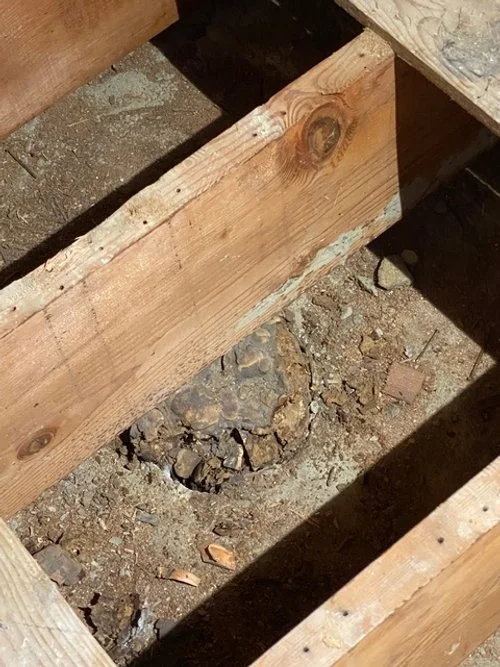Stumped by a Stump
- by Linda Young at the conclusion of the Church’s restroom upgrade project Oct. 2023
Curiosity can take us down strange and revealing paths. During demolition of the “old” 1960 restrooms at Arlington Community Church in Kensington, CA., I watched with curiosity as the skeletal structure of this area of the church was revealed. Old wires and cable pipes were found in odd places, such as a fat pipe running up through the exterior wall just as you step into the new “hallway” to restrooms. When investigating, we found the pipe went through the ceiling and out the wall to the balcony. It was capped there, but opening it, we found wires with no purpose. Something probably left over from the 1947 entry. But my curiosity was most aroused by something revealed under the floor of the women’s restroom. When the floor was opened to find routs for new pipes, I noticed something perfectly round on the ground under the floor joists. It looked like an elephant footprint, but a worker went down and helped check it out. It was wood! It was a round piece of wood almost a foot across, that had been surrounded by the “rat barrier”, a coating of cement on the ground. It must have been a tree stump!
With a little help from Javier, the church Caretaker, we collected some samples of the wood. Curious to find out what kind of tree had stood there, I reached out to an old friend in the Biology Department at UC Berkeley, Randy Shekman. He said yes, he could help. He knew someone who might be able to identify the species. So, a few months ago I delivered a little box of dark bits and chunks of wood with photos of the stump to Randy. Several weeks later I received a text forwarded from Lew Feldman, director of the Berkeley Botanical Garden: “I’ve had a look at the anatomy of the cell types making up the mystery wood you previously sent. I can say for sure that it is a gymnosperm, not a flowering plant. Further, the wood anatomy suggests we are looking at wood from a member of the pine (Pinus) family. Beyond that, I am not skilled enough to offer any additional insights.”
Thrilled, but a little disappointed to not have more detail, I accepted the answer and sent a thank you note. But apparently his curiosity persisted. The very next day Randy forwarded a 2nd text: “I did some more reading yesterday after I first wrote you. It seems it is also possible that this could be a Coast Redwood.”
Apparently, his curiosity spread to colleagues, because weeks later, Julie Stokstad, who has been a long-time volunteer at the Botanical Gardens, sent me the attached article by Lew Feldman in the Garden’s newsletter. “Given that this stump persisted for such a long time, and the fact that redwoods are well-known to resist decay and deterioration, we concluded that the stump was most likely that of a redwood.” Now, we not only know that ACC’s building inhabits Ohlone land, but that at least one Coast Redwood stood here as well. It is well documented that vast forest of redwoods once stood in this area. So, when you relax in our new restrooms, think with curiosity to yourself: “You could be sitting under a coast redwood tree. How would that feel?”


